MARKETING
Step-by-Step Guide to Advertising on Facebook

Facebook marketing has become a staple for social media marketers over the last few years, and the credit goes to its massive user base. With over 3.06 billion users worldwide, 89% of businesses run Facebook ads as their primary advertising method.
But, running your Facebook ads is a tough nut to crack.
With soaring competition and dynamic algorithms, your ad strategy might end in a black hole, draining your budget altogether.
Running your Facebook Ads needs a well-devised strategy, constant market research, A/B testing and some crucial metrics to map its success.
In this guide, we’ve laid down the step-by-step process of running Facebook ad campaigns. And to make it even better, we put together a checklist to help you keep all of your campaign details straight.
With this resource in hand, you can build the right ad for the right audience on this expansive platform.
In this blog, we’ll cover the following:
Why advertise on Facebook?
With nearly 1.9 billion users every day, Facebook offers a unique opportunity for marketers to augment their organic efforts through advertising campaigns.
Compared to the post boost, Facebook Ads have a higher CTR (click-through rates), lower CPM (Cost per 1k impressions), lower CPC (Cost-per-click), and better reach. It also makes sense to run Facebook ads in 2024 when your target audience is worth 2.249 billion.
If you’re still on the fence, these reasons might convince you:
- Build brand awareness. Facebook ads are displayed impulsively while scrolling the feed, whereas Google ads only appear when a user heads over to the search engine. Also, the graphics in Facebook ads garner more clicks and higher awareness from the customers through emotional marketing.
- Reach wide target customers. Facebook has vast user data, with audience segmentation elements like interests, behaviors, income, spoken languages, and education. Advertisers can leverage these metrics to target a specific set of customers without wasting their budget.
- Gain powerful insights. Ad performance tracking is recorded and available in real time. You can use these metrics to understand what’s working and how to improve your advertising strategy for future campaigns.
I’ve even got some real numbers to prove my point here.
However, the fortune of your Facebook ads starts with the basics. In my experience, most businesses end up messing with the ads because of the incorrect ad manager setup or a weak foundation.
The trouble is, with both time and money on the line, there’s not much room for oversight.
To help fine-tune your system, let’s first start with an overview of Facebook Ads Manager and its significant features.
Facebook Ads Manager
Before starting with your first ad campaign, you’ll need to set up your Facebook Ads Manager account. It is a sophisticated dashboard that provides users with an overview of all their campaigns.
Over the last few years, the Ads Manager has added various features for the advertisers – complicating the interface.

For quick navigation, the Ads Manager has three campaign structures:

- Campaigns. This is the first part of your campaign structure. The campaign gives an objective of your ad. You can choose what you want from your ad: Awareness, Traffic generation, Sales, App promotions, leads, or engagement.
- Ad sets. This defines your targeting strategy – the audience to which you want to display your ads. You can have multiple ad sets per campaign and different budgets for each.
- Ads. This is the final step in your ad creation. You can create multiple ads per ad set. Try and test with various ad formats and different ad placements.
- Automated ads. This section is only available if you’ve created Automated Ads. This offering is best fit for beginners and those looking for a simple way to gain exposure. The trade-off: You lose the precision you may achieve manually. This section will list all your Automated Ads and a summary of recent results.
How to Run Facebook Ads
- Create an account with Facebook
- Start creating an ad through Facebook Ads Manager
- Choosing buying type
- Choose an objective
- Name your campaign
- Choose your Special Ad category
- Choose A/B split testing
- Set performance goals
- Choose your budget and schedule
- Choose your ad placement
- Ad set up
- Choose ad format
- Create your ad
- Monitor your ad’s performance
- Report on Facebook ad performance
So, now you know the power of Facebook ads manager. Now, let’s explore how to actually run ads. I’ll demonstrate the steps below.
1. Create an account with Facebook Ads Manager.
To use the Facebook Ads Manager, I need a Facebook Business Page (learn how to set one up here). This is because I can’t run ads through personal profiles.
If I were managing someone else’s ads, I would need an admin, editor, or advertiser access to set up ad campaigns.
The next step is setting up my payment. This payment method is used by the Meta business account to charge me for active ads.

Once set up, the Ads Manager becomes the control center for your Facebook ads.
I can also navigate to the Ads Manager through my Facebook page account. On the left panel of the page, click on Ad Center and scroll down to find a link to Ad Manager.
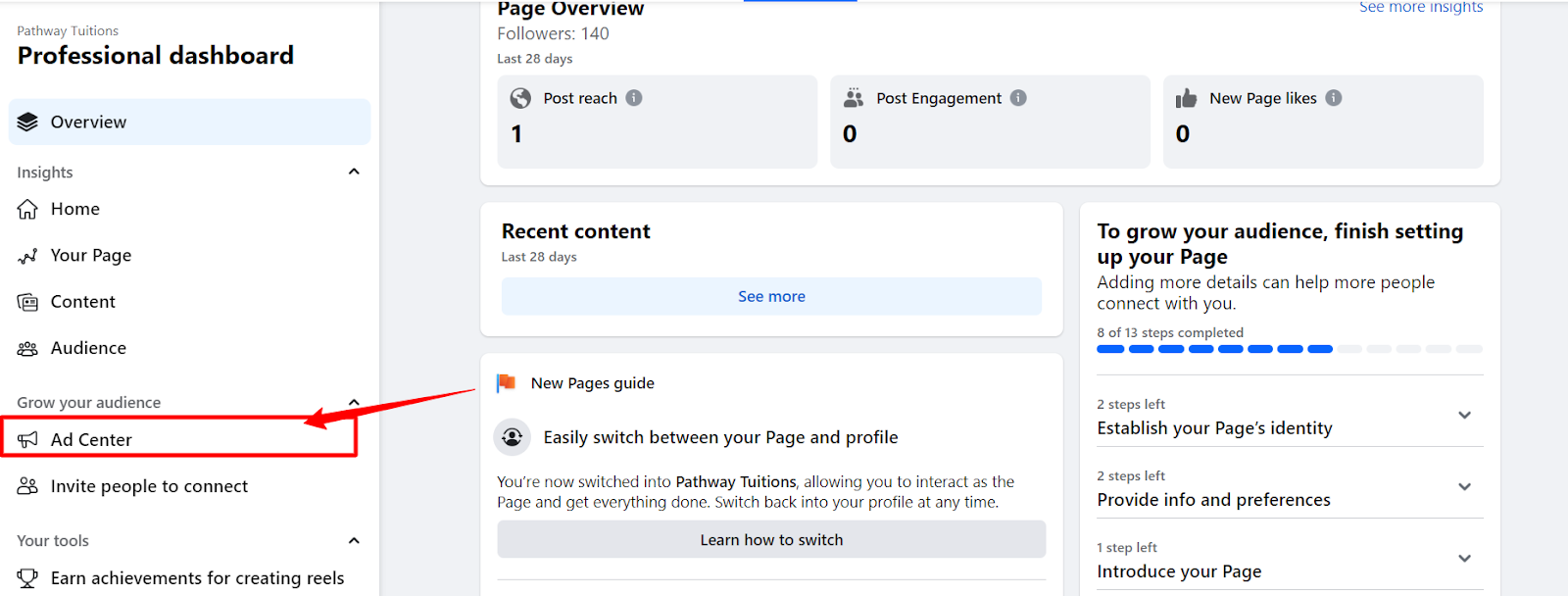
2. Start creating an ad through Facebook Ads Manager.
Once I log into the Ads Manager, I can see a performance dashboard where all of your campaigns, ad sets, and ads will be listed, including the results they’ve driven for my Facebook page.
Unless I’ve already created an ad for my Facebook page, this dashboard will be empty.
To create a new campaign, ad set, or ad through the Facebook Ads Manager, tab over to the type of ad I want to create. Click the green “Create” button to the far left of these ad types, as shown below.
3. Choose buying type.
Meta gives users two choices for buying type: Auction and Reservation.
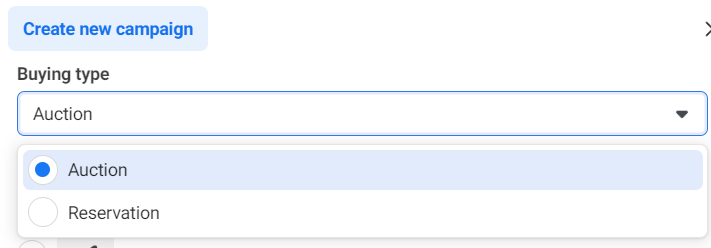
Auctions offer more efficiency, flexibility, and choice for campaign objectives. I can set a daily or a lifetime. Ads can be placed on Facebook, Instagram, Messenger, and Audience Network. Advantage campaigns are available.
Reservation offers less flexibility but lets you plan your campaigns in advance with more predictable results. Ads can be placed on Facebook and Instagram. Reservation also offers frequency control.
To get a better understanding and clear difference between the two, read their help guide.
4. Choose an objective.
Facebook Ads Manager, like many social media advertising networks, is designed with my campaign objective in mind. Before getting started, Ads Manager will prompt me to choose an objective for my campaign.
There are six different objectives to choose from. The list has been cut down from 11 objectives to only six:
By choosing one of these objectives, I’m giving Facebook a better idea of what I’d like to do so they can present me with the best-suited ad options. As shown in the screenshot above, Facebook’s ad options include:
- Awareness. This is great for raising awareness for your brand and boosting customer reach, video views, or store location awareness.
- Traffic, for directing traffic to the website, Instagram page, a specific landing page, or even Whatsapp.
- Engagement. This is great for higher engagement on posts, websites, or any link that you share. Increases the likelihood of receiving messages and conversions.
- Focusing on leads. That includes any action that you want customers to do, like filling out the form, purchasing, booking a meeting, and so on…
- Sales. This objective is for people who are likely to make purchases through a catalog, calls, Messenger, Instagram, or websites/apps.
- App promotions. This is targeted for app installs or compelling audiences to make in-app purchases.
I’d say, setting a campaign objective can decide the fortune of your ads. Choosing the wrong objective will leave your ad unidirectional – giving poor results.
Laia Quintana, marketing head of TeamUp, considers this step a game-changer. She says, “The objective-based approach of Ads Manager allows us to focus on what truly matters — getting more app installs.”
By selecting ‘App Installs’ as their campaign objective, TeamUp was able to leverage Facebook’s powerful ad algorithm to reach potential customers. “This not only optimizes our ad spend but also increases the efficiency of our marketing efforts,” Quintana says.
Featured Tool: Facebook Advertising Checklist

Don’t forget to download the Facebook Ads Checklist and save it for Facebook ad campaign best practices.
5. Name your campaign.
Next, I name my ad campaign so it resonates with my business and goals. For instance, you can name your campaign “XYZ Traffic,” with the brand name being XYZ and the objective being the traffic.
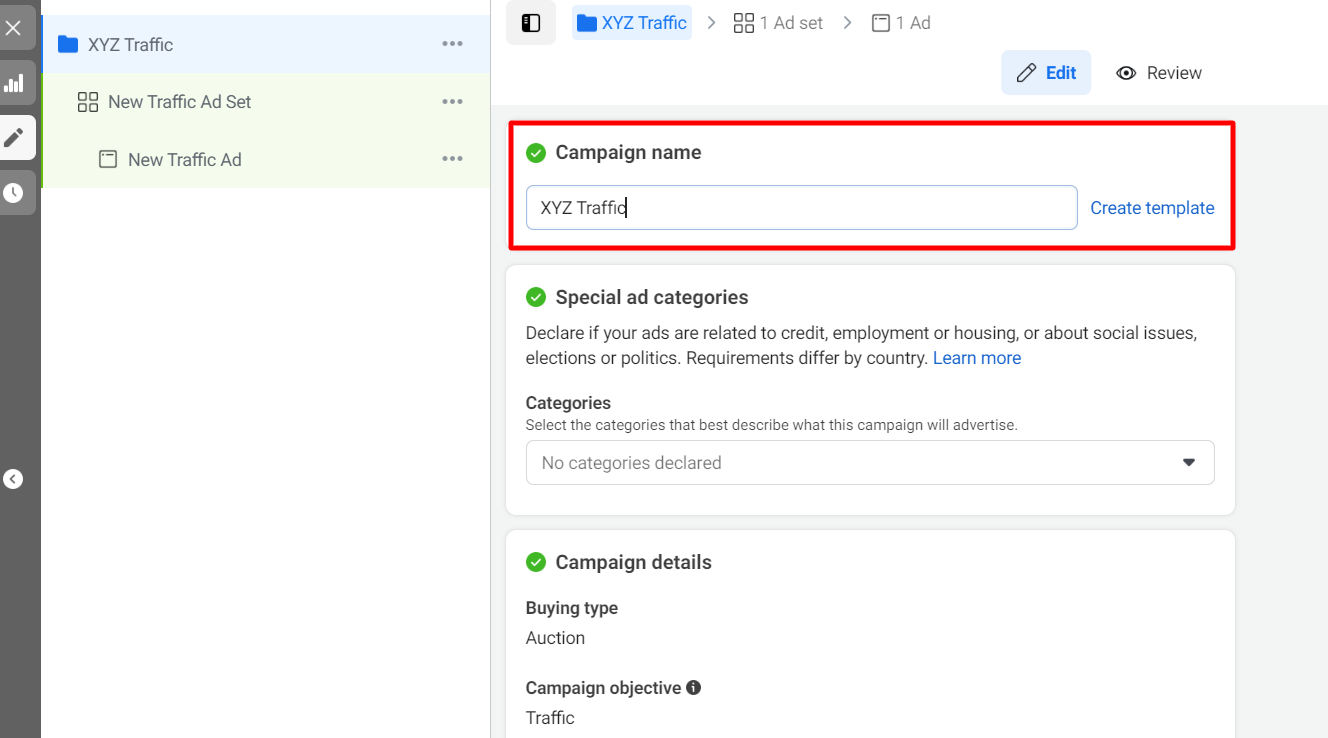
6. Choose your Special Ad category.
Facebook introduced a special ad category that limits the audiences for certain ad types to protect them from discrimination. Though these may limit the audience reach, I’d say it’s a good approach to prevent age and gender-based discrimination.
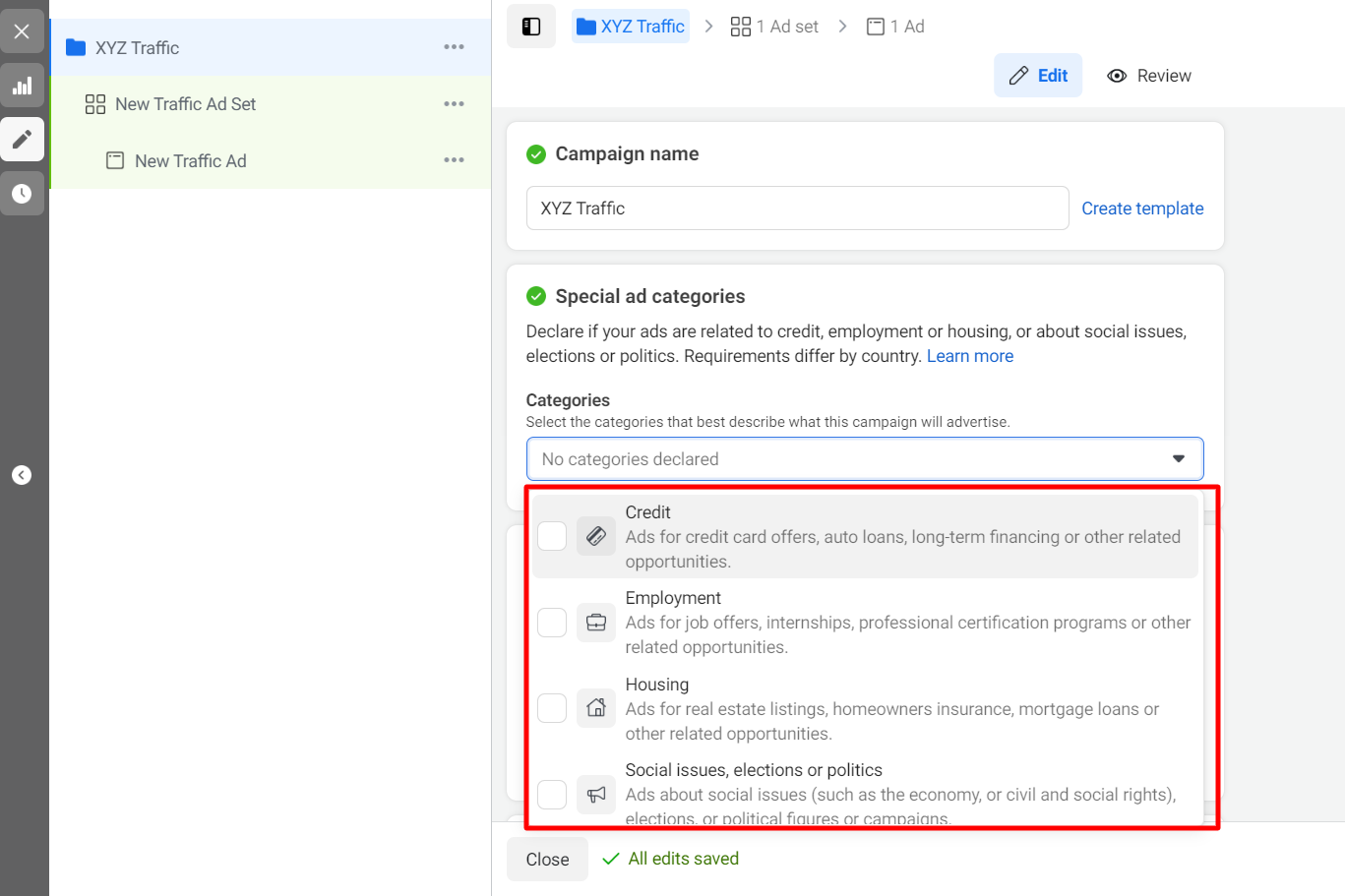
The following categories are included under the special ad category:
- Credit.
- Employment.
- Housing.
- Social issues.
Selecting these categories ensures that your ads remain compliant with Facebook’s advertising discriminatory policies.
7. Choose A/B Split testing.
Performing the A/B test for my ads can help me choose the right version of your ad. I can experiment with different images, variations of texts, ad placements, and CTAs to maximize my ad performance and save my budget.
I can toggle on or off your AB test option to enable split testing.
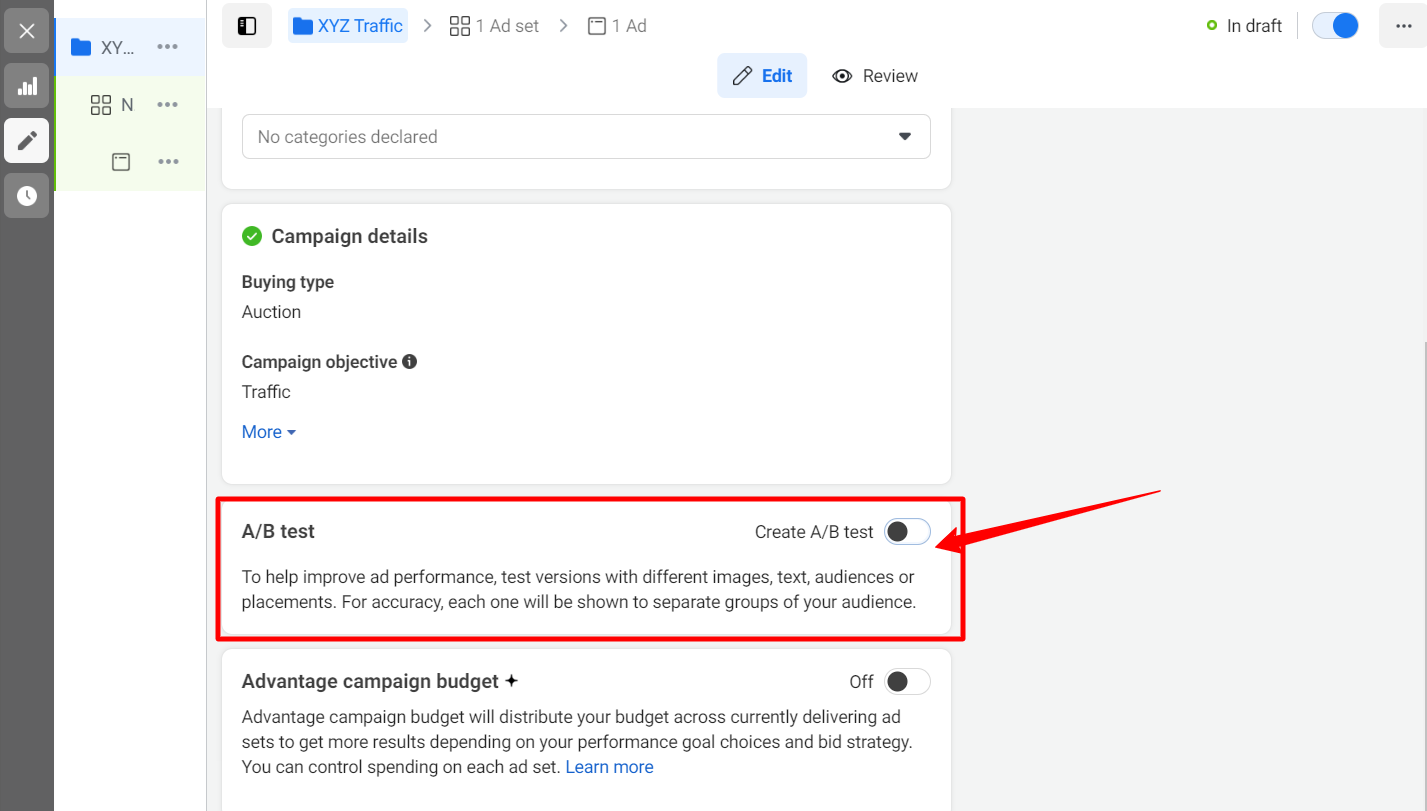
8. Set performance goals.
After I have created a campaign, the next step is to create a specific ad set, which estimates my audience reach based on demographics and geographical location.
For each type of campaign objective (refer to step #3), there are a few sets of performance goals – which actions advertisers want their audience to perform.
This campaign objective, for example, I chose, aims at driving traffic. The conversion location displays the location where I want to drive my ad traffic. (Website, Mobile app, calls, or Instagram profile).
If my goal is to drive traffic to my website or to the messenger, the Ads manager gives various selections for performance goals — from maximizing the number of clicks to maximizing the number of conversions and more.
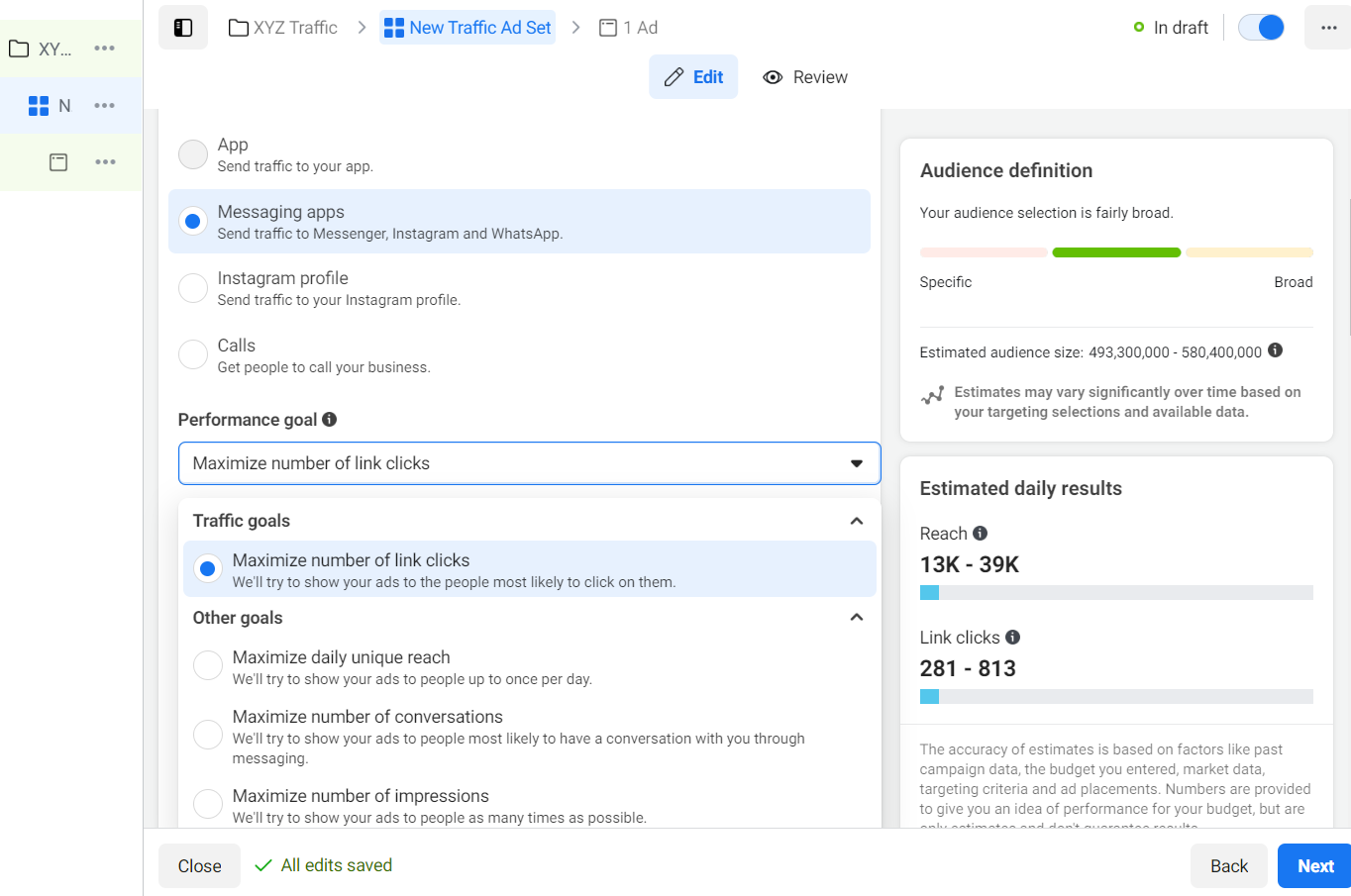
On the right side, I get an estimate of your audience reach with the current selection of performance goals and audience filters.
9. Choose your budget and schedule.
The ad budget represents the maximum amount of money that I’ll spend on the campaign. I can set either a daily or a lifetime budget for my ad campaign.
Facebook allows me to set either a daily budget or a lifetime budget. Here’s how they differ from each other.
- Daily budget. If I want your ad set to run continuously throughout the day, this is the option I would want. Using a daily budget means that Facebook will pace my spending per day. Keep in mind that the minimum daily budget for an ad set is $1.00 and must be at least 2x your CPC.
- Lifetime budget. If I were looking to run my ad for a specified length of time, I would select the lifetime budget. This means Facebook will pace my spend over the period I set for the ad to run.
- Choose your audience.
My next step is to configure my target audience. I can do this for each ad set that belongs to the same campaign. Setting up my target audience can adjust the reach of my ad and slash my ad spends to a large extent.
This tweet says it all:
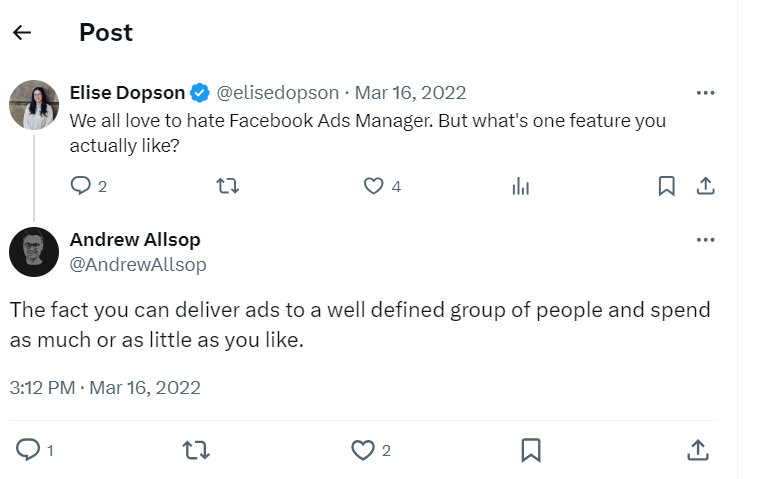
Facebook has limited the target audience filters to three specifics: location, gender, and language.
If I need a more specific audience type, Facebook uses the new Meta Advantage+ audience feature to broaden the audience. With this feature, Meta uses AI to create a specific audience based on the specific information or insights from Pixels.
I can even switch to an old custom audience settings in the ad creation settings. Meta also predicts and compares the better targeting option for your ad campaigns.
If you are just starting, I recommend you experiment with several different targeting options until you reach an audience that fits just right.
Also, if you’re wavering between choosing a specific audience over a broad one, consider your objective. Let’s say, for the objective of driving traffic, you’ll probably want to focus on the type of people you know will be interested in your offering.
However, if you’re looking to build brand awareness or promote a widely appealing offer, feel free to focus on a more general audience.
Once I find a group that responds well to my ads, Facebook allows me to save these audiences from being used again later — so I may not need to repeat this step once I’ve been running Facebook ads for a while.
11. Choose your ad placement.
Besides my target audience, my ad budget may also be affected by the ad placement. Different ad placements may have different conversion rates, and different objectives may have different ad placements.
Like their target audience, Facebook has an AI-powered Advantage+ placement to maximize your ad reach. Meta’s AI system will automatically place ads across multiple places based on where they’ll perform the best.
For experienced advertisers, you can decide on the ad placements by choosing the manual placement. This will give you various filters to set to streamline ad placement such as the devices, platforms (like Instagram, Facebook & Messenger), placement types and content type exclusions.

Here are the several ad placement locations:
- Feeds.
- Stories and reels.
- Reels overlay.
- In-stream.
- Search results.
- Messages.
- Apps and overlay.
12. Ad set up.
Now that I have created a campaign and the ad sets, it’s time to set up my ads. Here, the first step is to set up my meta account. I can choose whether I want to connect my Facebook account with Instagram.
By doing so, I can display these ads on my Instagram feed or story.
I can choose an existing post or create a new ad using the ad setup option. Additionally, Facebook has a new creative mockup feature where advertisers can create a mockup of ads to test which type of ad suits their audience’s needs.
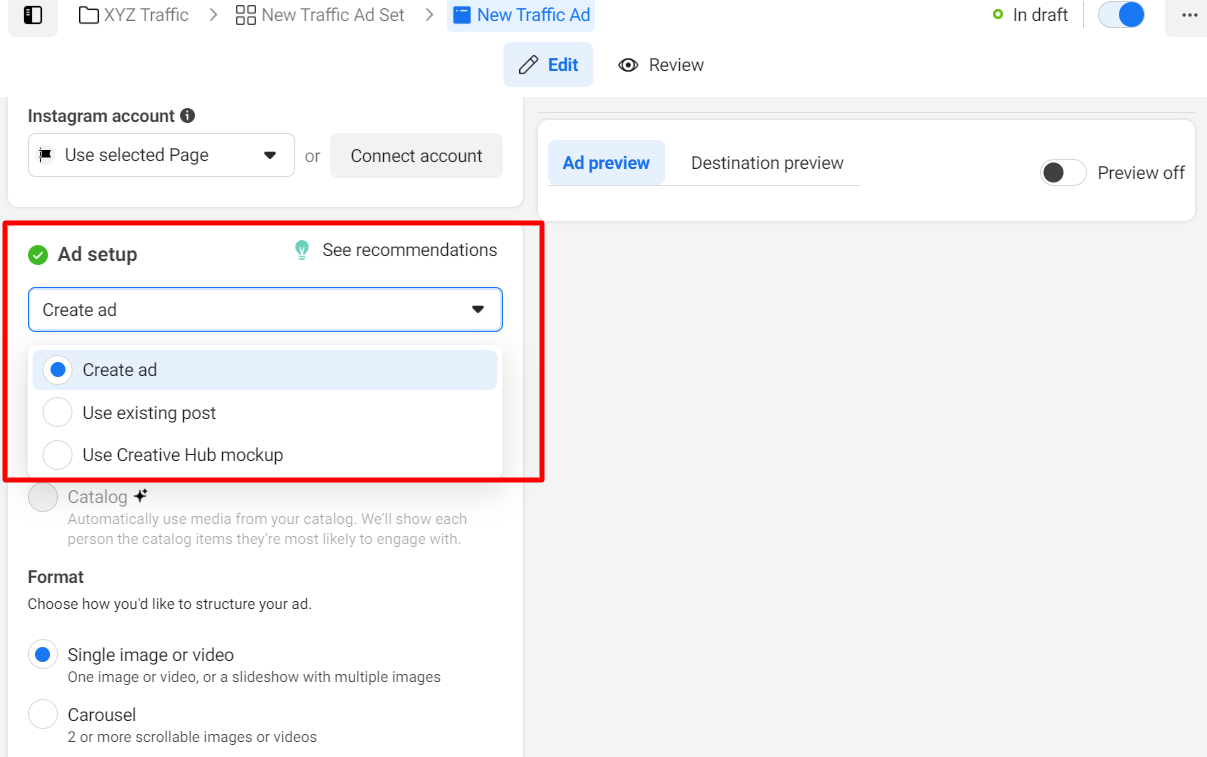
13. Choose ad format.
This ad option is broken down into two formats: Links and Carousels. Essentially, this means that I can either display a single-image ad (Links) or a multi-image ad (Carousel) with three to five scrolling images at no additional cost.
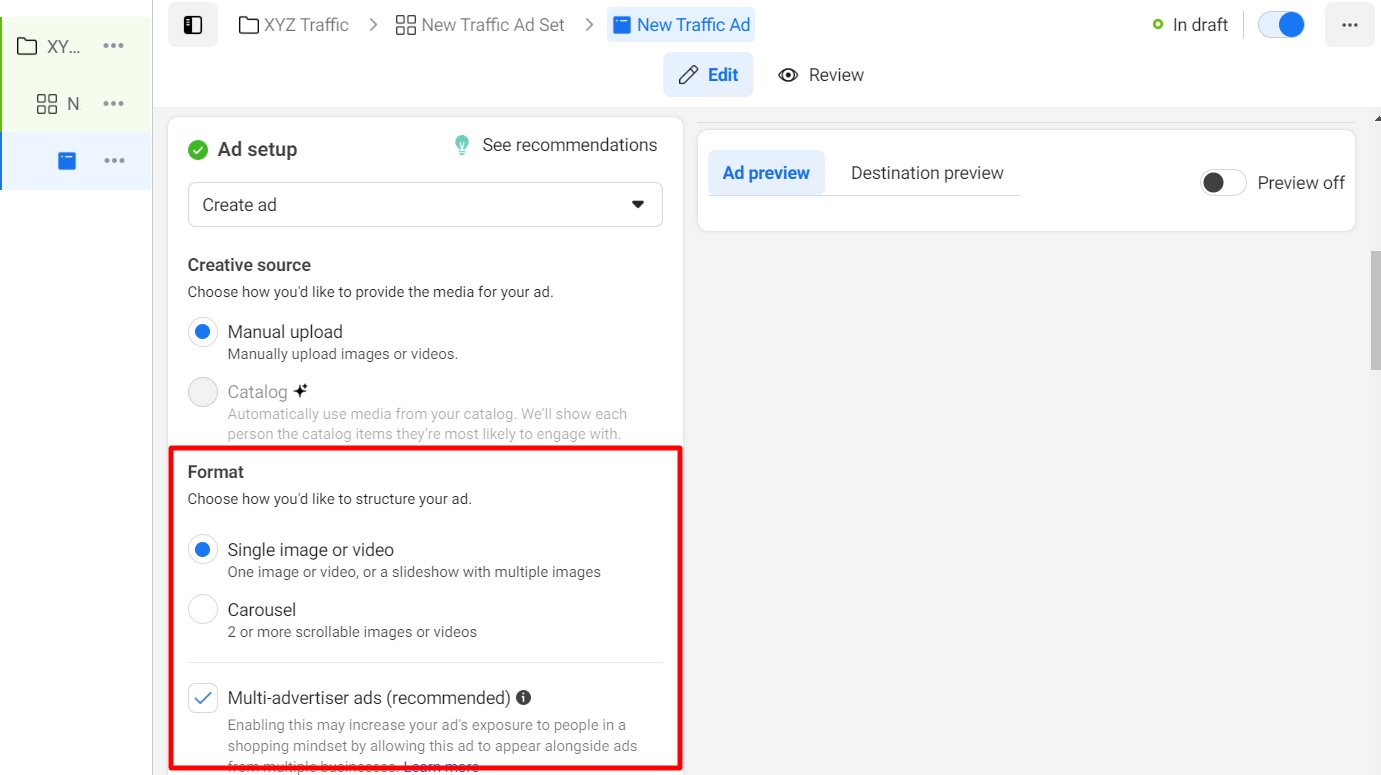
A Links ad will be displayed like this.
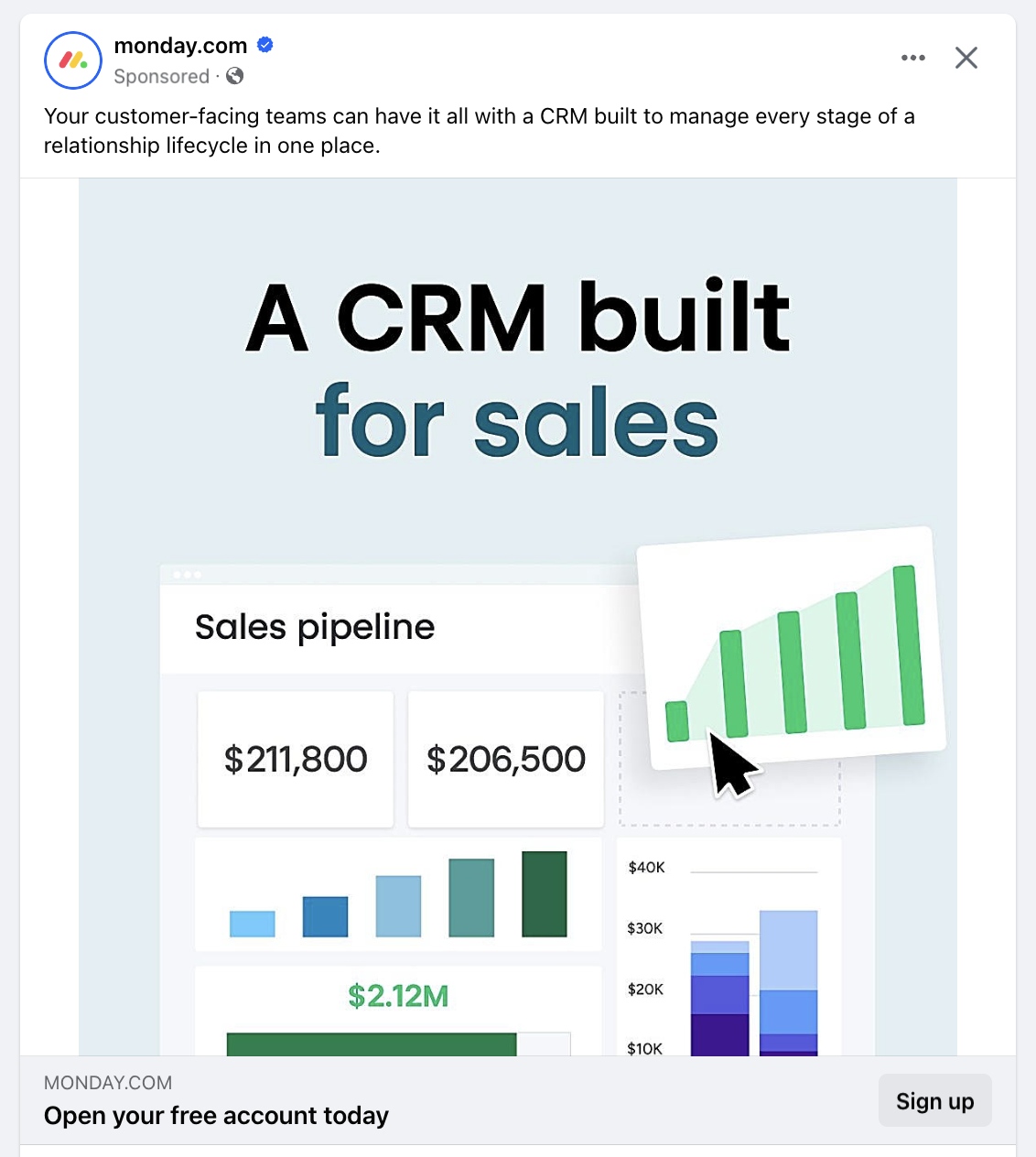
A Carousel ad will be displayed like this.
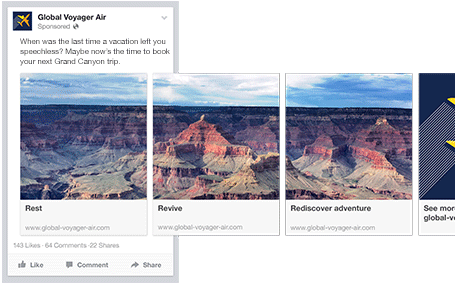
Once I decide between the two, I need to upload my creative assets. It’s important to note that for each type of ad, Facebook requires users to adhere to certain design criteria.
For single-image ads, Facebook asks that users adhere to the following design recommendations:
- Text: 125 characters.
- Ad headline: 25 characters.
- Image ratio: 1.91:1.
- Image resolution (including CTA): 1080 x 1080 pixels.
For multi-image ads — also known as Carousel Ads — Facebook provides the following design recommendations:
- Recommended image size: 1080 x 1080 pixels.
- Image ratio: 1:1.
- Text: 125 characters.
- Headline: 40 characters.
- Link description: 20 characters.
Remember that these are the ad options for the “Traffic” objective.
If I selected “boost your posts,” I would be presented with different ad options like the Page Post Engagement: Photo ad. This ad has a unique set of design recommendations.
Once I select an ad type, the Ads Manager will prompt me to identify how I’d like to display my ad. The options they provide are as follows: Desktop News Feed, Mobile News Feed, and Desktop Right Column.
Here’s how each ad would appear.
Desktop News Feed
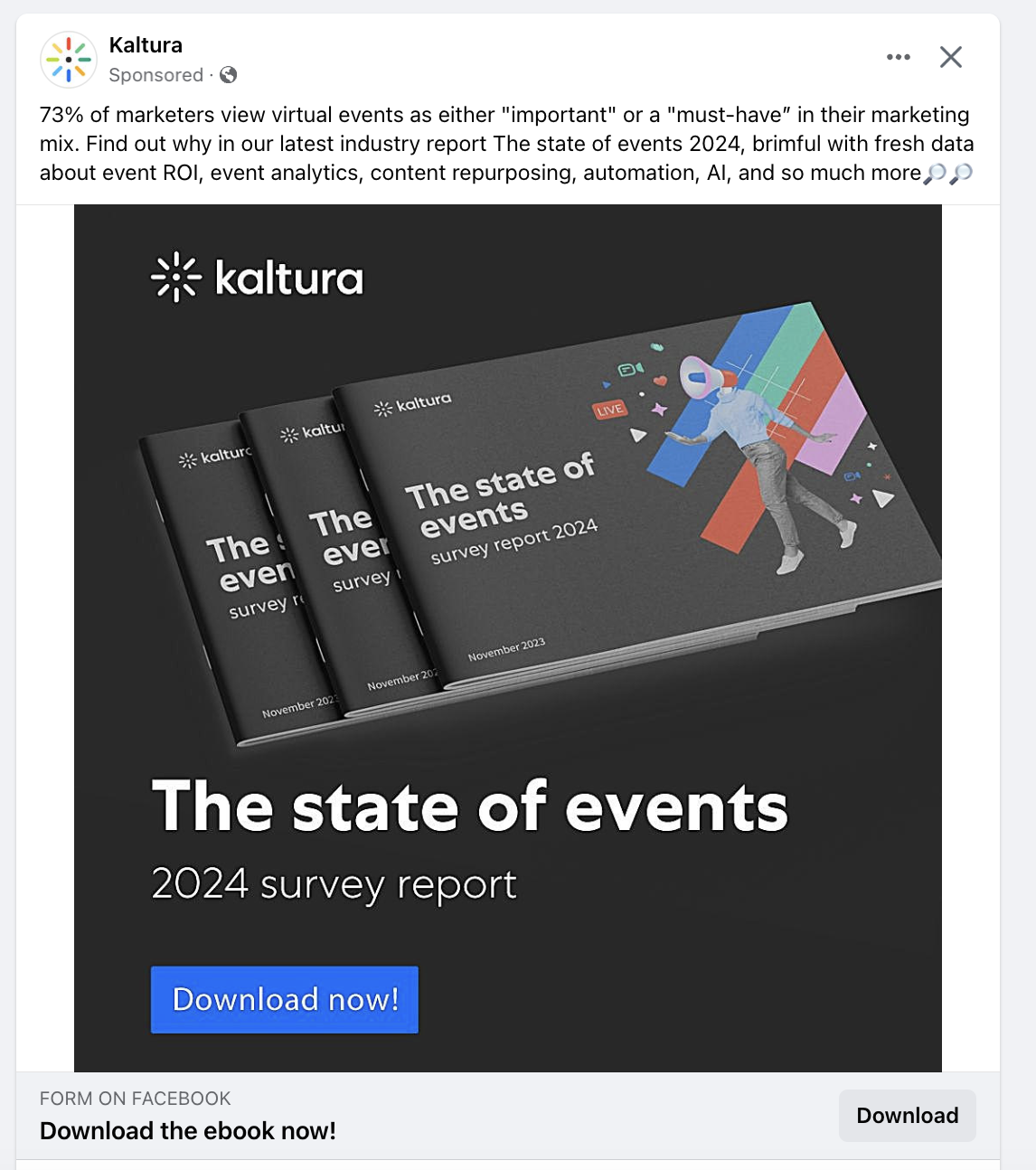
Mobile News Feed
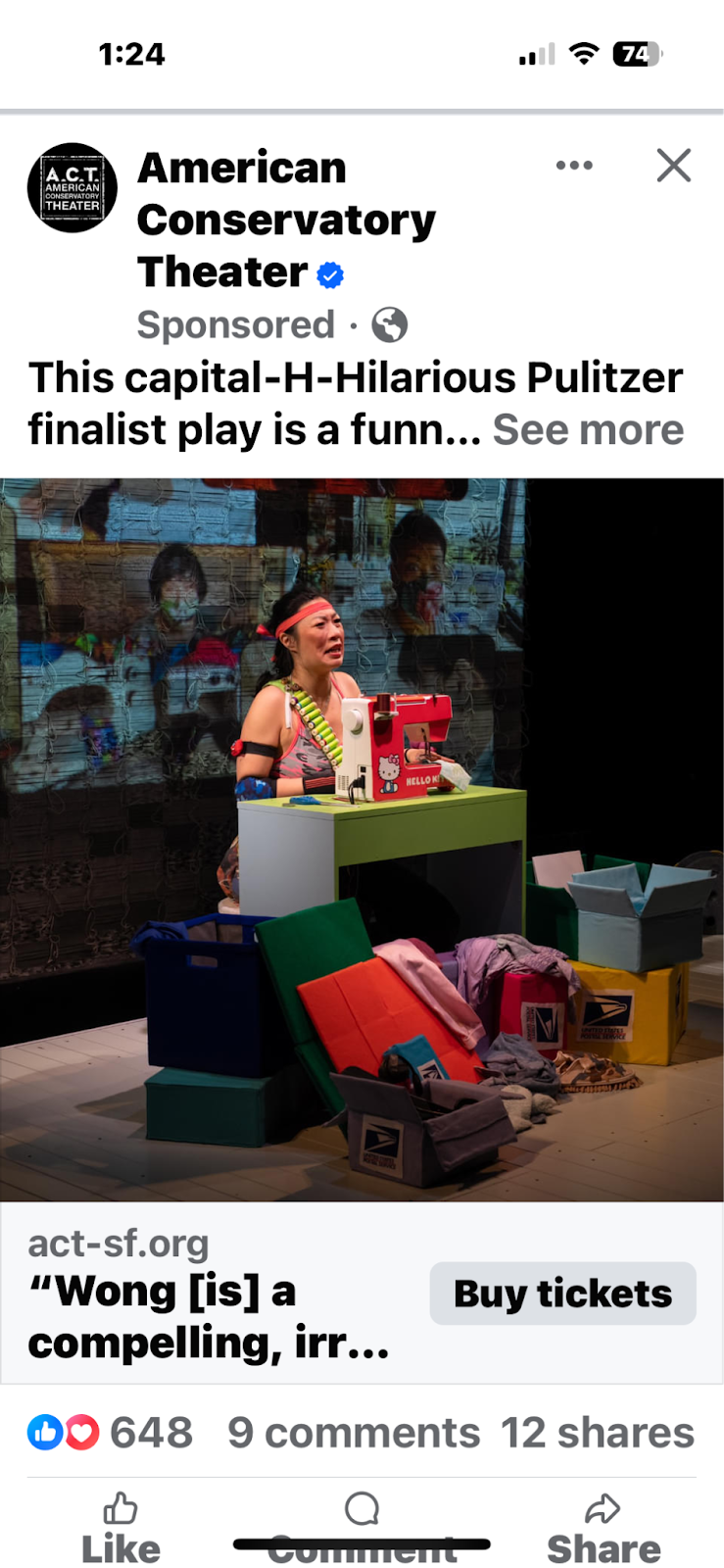
Desktop Right Column
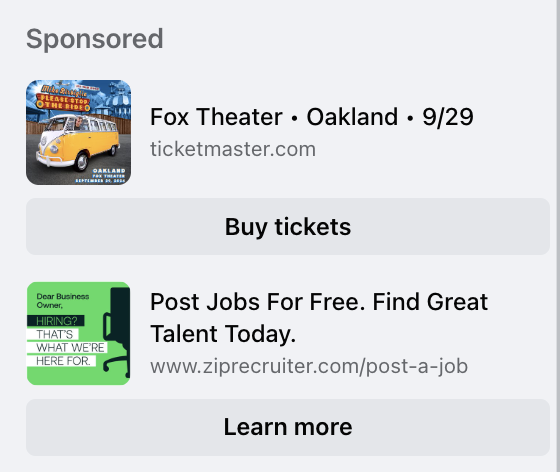
Be aware if your ad isn’t associated with a Facebook page, you’ll only be able to run Desktop Right Column ads.
14. Create your ad.
The final step is to create my ad with a graphic and descriptive text. Once I choose to upload the media files, I can either use the existing ones in my Facebook library or upload them from my computer or mobile device.
Here’s what else my Facebook ad includes:
- Primary text. You can add up to 5 primary texts to use on your different ad placements. Display your product savings and offers here.
- Headline. This appears below the visual and is meant to grab the audience’s attention.
- Description. The appearance of descriptions may vary based on ad placements. Add the text here to give a detailed description of your ad copy.
- Call-to-action. Choose what action you want your audience to perform.
15. Monitor your ad’s performance metrics.
Once my ads are running, I have to keep an eye on how they’re doing. To see their results, I need to look in two places: the Facebook Ads Manager and my marketing software.
There are over 350 different metrics and terms in Ads Manager and chances are that you might get bogged down in this massive pool of data.
According to Facebook, here are some of the key metrics to look for (and their definitions):
- Performance, which can be customized further to include metrics like results, reach, frequency, and impressions.
- Engagement, which can be customized further to include metrics like Page likes, Page engagement, and post engagement.
- Videos, which can be customized further to include metrics like video views and the average percentage of video viewed.
- Website, which can be customized further to include metrics like website actions (all), checkouts, payment details, purchases, and adds to cart.
- Apps, which can be further customized to include metrics like app installs, app engagement, credit spends, mobile app actions, and cost per app engagement.
- Events, which can be further customized to include metrics like event responses and cost per event response.
- Clicks, which can be further customized to include metrics like clicks, unique clicks, CTR (click-through rate), and CPC (cost per click).
- Settings, which can be further customized to include metrics like start date, end date, ad set name, ad ID, delivery, bid, and objective.
16. Report on Facebook ad performance.
I can receive custom reports via email as well. Here’s how to set it up:
- Navigate to “Analyze and Report” through the upper main menu.
- Choose “Ads Reporting.”
- Select “Create Custom Report.”
- Select and open a saved report.
- Choose “Save As” next to the save icon. Give your report a name and check “Schedule Email.”
- Follow the prompts to edit and confirm your reporting preferences.
While there are certainly a lot of details to keep straight when planning a paid Facebook ad, it’s important that you don’t lose sight of the big picture. Reporting on clicks and conversions from Facebook is important.
However, if you’re using URLs with specific UTM codes, you have an opportunity to measure your ads’ full-funnel effectiveness using your marketing software.
Tracking URLs will help your marketing software keep track of how many leads, or better yet, how many customers you’ve gained from your advertising efforts. This information is useful in determining the ROI of this source and can also be used to inform your overall Facebook marketing strategy.
If you’re a HubSpot customer using our ads tool, this process is already taken care of for you. You can also create unique tracking codes for your Facebook campaign by navigating to the “Tracking URL Builder” on the Reports homepage.
All you’ll need to do is plug in the URL, attach a campaign, and choose the source you want the URL to be attributed to in your Sources Report.
Once your ad launches and you start getting conversions on your website, you’ll be able to easily track how many visits, contacts, and customers you’re generating.
How to Create Facebook Ads
To create a Facebook ad that drives measurable results, follow these tips.
1. Define your target audience and create ads for them.
While creating ads, it’s tempting to make your messaging vague enough to resonate with everyone. But if you want your Facebook ads to be effective, tailor them to a specific audience.
Before you start creating images/videos and writing ad copy, figure out who is most likely to become paying customers. These are the people you should try to persuade with your ads.
Ryan Robinson, CEO of Right Blogger, accentuates the importance of the target audience.
Robinson says, “In my experience, it’s often beneficial to start with a slightly broader audience initially and then slowly refine it based on performance data. This allows you to gather insights about who is truly engaging with your ads before narrowing down too much.”
He gives a convincing example of leveraging the defined target audience mixed with various ad placements for one of his clients specializing in eco-friendly products: “We defined their target audience as environmentally conscious urban dwellers aged 25-45, and created visually appealing carousel ads showcasing the client’s products.”
From there, the team tested different ad placements and copy variations, until they found the sweet spot. Robinson says this boosted the Facebook ad campaign’s website traffic by 23% and online sales by 13% compared to our previous campaigns.
“The continuous optimization based on performance data helped us refine our targeting and creative approach, leading to a better return on ad spend and improved brand awareness among our ideal customers,” Robinson says.
That said, continuous optimization is the key to success in your ad campaigns.
To take things up a notch, use Facebook’s advanced targeting feature to add (or remove) people who follow certain apps, events, or pages. This may take a bit of time, but you’ll increase the ROI of your ad campaigns.
Although Kylie Haack is a real estate company that sells properties, this ad is targeted specifically toward people who want to appraise their homes — not people who want to buy.
2. Write a catchy but clear headline.
Your headline is usually the first thing people will see on your Facebook ad. If it doesn’t catch people’s attention, it will reflect negatively on your click-through rate (CTR) and conversion rate.
With headlines, don’t try to shove your offer down people’s throats. Instead, be clear and conversational, and try to communicate your product’s benefits, if possible.
In this ad, HubSpot is urging people who need help with Facebook or Instagram marketing to check out their free guide on the topic. Their headline for this ad is: Maximize Lead Generation.
This simple, but powerful, headline summarizes the benefits people would get if they read and apply what’s in the free guide.
Pro Tip: To improve your headlines and get better results, run split tests (more on that below). These tests can help you determine the messaging that gets people to convert.
3. Don’t use text-heavy graphics.
According to Facebook, images with less than 20% of text perform better. So try not to design graphics with too much text on them.
Text-heavy graphics can distract a prospect from your message, so it’s best to let the graphics speak for themselves. For example, the ad below has too much text.
To prevent this from happening, you can use a longer ad caption. But if you must use text on your image, try using a smaller font and fewer words to reduce the proportion of text to image.
4. Use simple and easy-to-understand language.
Ad copywriting is not an avenue to channel your inner Victorian author. It doesn’t matter if you’re an Insta-famous poet or you’ve won a Pulitzer — using verbose language in your Facebook ads will confuse your prospects.
When writing ad copy, the main goal is to make it easy for anyone to understand. When a prospect sees your ad, they should instantly know:
- What your offer is.
- How it will benefit them.
- What to do next.
That’s why I love this Mailchimp ad, which helps people with online stores automate their marketing.

The copy in this ad is simple and to the point: “Automate your marketing with Customer Journey Builder and watch your orders grow.” Then, Mailchimp gives a simplified visualization of what the automation process looks like.
This helps prospects understand exactly how the Customer Journey Builder feature can take things off their plate and help them grow their business.
5. Use social proof in your ads.
When a prospect sees your Facebook ad — especially if it’s the first time — they may not trust your brand or offer immediately. And that’s okay.
It’s your job to convince them that you’re the real deal. A great way to do this is to use social proof in your ads.
Social proof comes in many forms — reactions, comments, shares, testimonials, and reviews. Featuring these in your ads shows prospects that other people have worked with your brand and purchased your offer without any regrets. Once they see this, they may be convinced to be your customer, too.
Before Adobe acquired the company, Figma was really good at using social proof in their Facebook ads.

In the ad above, the product design lead at Onfido, Steve Denis, walks people through how Onfido uses Figma to organize and scale its design systems. The message is simple: If other companies trust Figma to meet their design needs, you can, too.
6. Match your Facebook ad to your landing page.
When you run ads on Facebook, you’re essentially telling your audience that if they click your ad, they’ll get exactly what you’re offering on the page your ad leads to.
There’s no quicker way to lose the trust of your audience and increase your bounce rates than to send people to a landing page that has absolutely nothing to do with the offer they were interested in.
When designing your ad and landing page, ensure that the offer promised in the ad is the same as the one on the landing page. You should also include common elements, such as colors, fonts, and images, that will make it easy for people to recognize your offer and convert.
Here’s a great example of ad-landing-page sync.
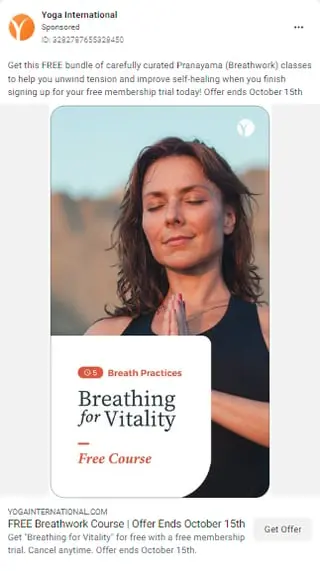
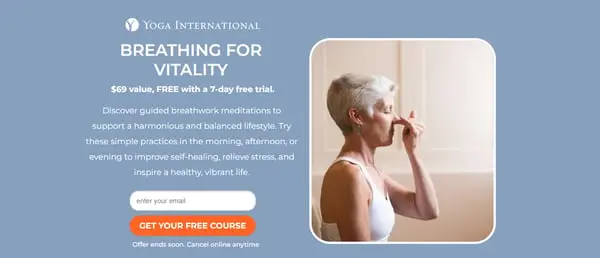
Here, Yoga International is advertising their free breathwork classes that can help people “unwind tension and improve self-healing.” The ad and the landing page it leads to share several design elements.
That includes brand colors, image choices, and fonts. These common elements help prospects feel like the landing page is an extension of the Facebook ad, rather than a new offer entirely.
7. Have a direct call-to-action in your ad.
The perfect Facebook ad should have a clear action the prospect should take.
Some ads are designed to spread awareness about a brand. Other ads lead users to installs, ebook downloads, or sales.
Ideally, ads do both. But to be on the safe side — and to get results that move the needle toward business growth — be clear on exactly what you want your prospects to do after they see the ad.
Calls to action like “Sign up,” “Follow,” “Download,” “Install the App,” and “Shop Now” clearly communicate the desired course of action to a prospect. Without a good CTA, people would see your ad, but they’ll have no idea what to do next.

In this ad, Dermalogica, a skincare company, advertises a power trio of three products. Plus, the bundle is less than half of the original prices of the individual products.
The ad is straightforward. It says what the product is, what the discount is, and the perk (free shipping) you get if you buy the product.
The “Shop Now” call-to-action is direct. This indicates that Dermalogica’s goal is for people to click the link and buy the product package.
8. Run A/B tests.
The only way you can improve your Facebook ads is to run split tests on everything — from the headline to ad copy to visuals and CTAs. Sometimes, an ad might not perform well because the copy isn’t convincing enough or the visuals aren’t eye-catching.
To know for sure, create different variations of the same ad — changing one thing at a time — and publish them. Let them run. Then, check to see which version(s) gets the most likes, comments, shares, and conversions.

In the instance above, Canva ran A/B tests on the ad creatives. In both ads, the ad copy is exactly the same, but the visual assets are not — one’s an image, and the other is a video.
Although the ad copy is the same, the change in visuals can spell a huge difference in the ROI from both ads.
Using Facebook Ads Manager for Your Next Campaign
Now that you know how to set up an ad, it’s time to create one of your own so you can spread brand awareness on Facebook, generate traffic, and gather leads from your ideal prospects on the platform.
Editor’s note: This post was originally published in September 2019 and has been updated for comprehensiveness.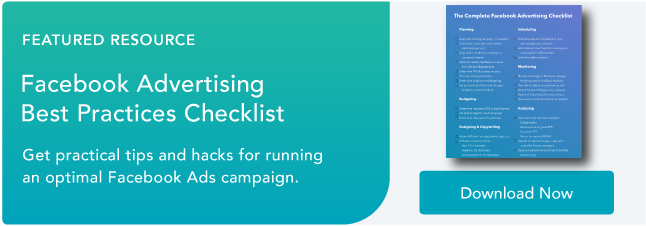
MARKETING
Navigating the Video Marketing Maze: Short-Form vs. Long-Form


Are you torn between using long-form or short-form videos for your small business marketing campaign? Well, you are not alone. Despite 89% of consumers wanting to see more brand videos, there is no one-size-fits-all answer about the ideal video length.
However, this should not deter you from creating an effective video strategy. In 2023, people watched an average of 17 videos per day, highlighting the influence of video content in today’s digital landscape.


Both short-form and long-form videos offer unique advantages and come with their set of challenges. Join me as I uncover the benefits and limitations of each video format to help you make informed marketing decisions.
What are Short-Form Videos?
Short videos typically range from 30 seconds to less than 10 minutes long. They are popular on social media platforms like TikTok, Instagram, Snapchat, and YouTube.
Short-form videos deliver brief yet engaging messages that quickly capture the viewer’s attention. Here are some popular types of short-form video content.
- TikTok Challenges
- Instagram Reels
- Snapchat Stories
- YouTube Shorts
- Twitter Video Ads
Benefits of Short-Form Videos
A previously cited report shows that 39% of marketers find short-form videos, ranging from 30-60 seconds long, more successful. The same study reports that 44% of customers prefer watching a short video to learn about a brand’s offerings.


So, it is evident that short-form videos have their benefits. Let’s take a closer look at some of them.
Attention-Grabbing
Short-form videos capture attention quickly, making them ideal for the fast-scrolling nature of social media platforms. Your audience is more likely to watch them in their entirety compared to longer content.
Cost-Effective Production
Creating short-form videos requires less time and resources compared to longer videos. As a small business owner with a limited budget, using short-form videos can be cost-effective.
Increased Engagement
Short-form videos engage viewers due to their crisp and concise nature. This results in more likes, comments, and shares that boost your content’s visibility and increase brand awareness.
Integrating short-form videos into your influencer marketing campaigns can further amplify your reach to new and diverse audiences.
Highly Shareable
Short videos are highly shareable. This makes it more likely for your viewers to share them, increasing their virality.


Want to get certified in Content Marketing?
Leverage the tools and channels to predictably and profitably drive awareness, leads, sales, and referrals—EVERYTHING you need to know to become a true master of digital marketing. Click Here
There are multiple benefits of adding video to your website including increased engagement, improved SEO, and enhanced user experience.
Limitations of Short-Form Videos
While short-form videos offer many advantages in content marketing, they also present some challenges.
Limited Message Depth
Due to their brief duration, short-form videos may struggle to convey complex or detailed messages. Longer videos might be more suitable if you need to communicate intricate information.
Competition for Attention
Standing out on platforms flooded with short-form video content can be challenging. You must create content that stands out to avoid becoming lost in the sea of other videos.
Shorter Lifespan
Short videos may lose their relevance with time. They can quickly get buried in users’ feeds, leading to a shorter visibility and engagement period than longer, evergreen content.
This means you must consistently create short-form videos to maintain audience interest over time.
Limited SEO Impact
Short-form videos may be more challenging to optimize for search engines than longer, more keyword-rich content. This can affect the discoverability of your content outside the social media scene.
What are Long-Form Videos?
Long-form videos are typically longer, ranging from a few minutes to several hours. They extend beyond a few minutes to several hours, providing ample time for in-depth topic exploration and detailed content.
These videos are particularly suitable for educational content, product demonstrations, and narrative-driven storytelling. Long-form videos are common on platforms like YouTube and Vimeo. Common types of long-form video content include:
- YouTube Series
- Webinars
- Educational Tutorials and Courses:
- Behind-the-Scenes Content
- Interviews and Conversations
Advantages of Long-Form Videos
Long-form video content is the fastest-growing segment, with videos above 30 minutes experiencing tremendous growth over the years. Let’s explore some of the benefits behind this growth.


Establishes Expertise and Credibility
Long-form videos allow you to provide in-depth information about various subjects, establishing your brand as an authority. Potential customers will likely trust and rely on your insights when you consistently deliver valuable content.
Builds Strong Audience Connections
The more your audience watches your videos, the more they become familiar with your content and brand. This consistent engagement promotes trust and loyalty, helping you create deeper connections with your audience.
Provide SEO Optimization Opportunities
Long-form videos keep your audience engaged for a longer duration than short ones. This signals search engines that your content provides value, resulting in higher rankings and increased visibility.
Besides, these videos provide opportunities to optimize for relevant keywords. This Attrock guide offers more insights into the value of SEO for your small business.
They Are Sustainable
Unlike short videos, well-produced and valuable long-form videos have an extended shelf life. They can continue to attract views and engagement over an extended period, contributing to a sustainable content strategy.
Instagram reels are also a part of short videos and you can get benefits from this platform by integrating it with your website. You can learn how to embed Instagram Reels on websites and get extra benefits from your Reels.
Drawbacks of Long-Form Videos
Despite their benefits, long-form videos also have certain limitations, including:
Attention Span Challenges
Between distractions, juggling tasks, and information overload, user attention span quickly diminishes. Viewers may lose interest and disengage from your long video before its conclusion.
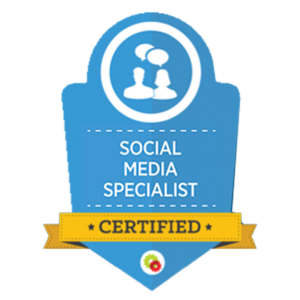

Are You Ready to Master Social Media?
Become a Certified Social Media Specialist and learn the newest strategies (by social platform) to draw organic traffic to your social media sites.
Complex Production Process
Creating high-quality long-form videos requires more resources, including time, equipment, and skilled personnel. This can be disadvantageous, especially for small businesses with limited budgets.
Platform Limitations
Some social media platforms and video hosting sites may limit video length, making it challenging to distribute long-form video content. You may then be forced to repurpose your content to suit various platforms.
Short-Form or Long-Form Videos: Which Are Better?
Now that you know the benefits and limitations of each format, which one should you choose? Short-form or long-form videos?
Well, it all boils down to considering several factors, such as:
Content Objectives
What do you want to achieve from your video marketing campaign? Short-form videos are highly effective for quick brand exposure and generating buzz. Long-form videos, on the other hand, contribute to a more in-depth understanding of the brand.
Target Audience Preferences
Audiences with short attention spans likely prefer short-form videos, while long-form videos appeal to those seeking a more immersive experience.
Similarly, short-form videos may appeal more to younger audiences, while older demographics may prefer the depth of long-form content.
Platform Dynamics
Various platforms support different content formats. Short-form videos are well-suited for platforms like TikTok, Instagram, and Snapchat. On the other hand, platforms like YouTube and Vimeo are better for hosting longer videos.
Industry Type
Short-form videos would be ideal if your industry thrives on trends, entertainment, and quick messages. However, long-form videos are effective for industries requiring in-depth explanations or educational content.
Bottom Line
Ultimately, choosing short-form or long-form videos depends on your business’s specific needs and goals. Since both formats have advantages and limitations, making a choice may prove difficult.
However, it doesn’t have to be an uphill task. The key lies in recognizing when to incorporate each video format into your marketing strategy. Understanding your audience and its needs allows you to combine both formats strategically, maximizing the benefits of each.
Continuously analyze performance metrics and adapt your video marketing strategy accordingly to ensure optimal engagement and conversion rates.
MARKETING
The Current State of Google’s Search Generative Experience [What It Means for SEO in 2024]
![The Current State of Google’s Search Generative Experience [What It Means for SEO in 2024] person typing on laptop with](https://articles.entireweb.com/wp-content/uploads/2024/04/The-Current-State-of-Googles-Search-Generative-Experience-What-It.webp.webp)
SEO enthusiasts, known for naming algorithm updates after animals and embracing melodrama, find themselves in a landscape where the “adapt or die” mantra prevails. So when Google announced the launch of its Search Generative Experience (SGE) in May of 2023 at Google/IO, you can imagine the reaction was immense.
Although SGE has the potential to be a truly transformative force in the landscape, we’re still waiting for SGE to move out of the Google Labs Sandbox and integrate into standard search results.
Curious about our current take on SGE and its potential impact on SEO in the future? Read on for more.
Decoding Google’s Defensive Move
In response to potential threats from competitors like ChatGPT, Bing, TikTok, Reddit, and Amazon, Google introduced SGE as a defensive maneuver. However, its initial beta release raised questions about its readiness and global deployment.
ChatGPT provided an existential threat that had the potential to eat into Google’s market share. When Bing started incorporating it into its search results, it was one of the most significant wins for Bing in a decade. In combination with threats from TikTok, Reddit, and Amazon, we see a more fractured search landscape less dominated by Google. Upon its launch, the expectation was that Google would push its SGE solution globally, impact most queries, and massively shake up organic search results and strategies to improve organic visibility.
Now, industry leaders are starting to question if Google is better off leaving SGE in the testing ground in Google labs. According to Google’s recent update, it appears that SGE will remain an opt-in experience in Google Labs (for at least the short term). If SGE was released, there could be a fundamental reset in understanding SEO. Everything from organic traffic to optimization tactics to tracking tools would need adjustments for the new experience. Therefore, the prospect of SGE staying in Google Labs is comforting if not entirely reliable.
The ever-present option is that Google can change its mind at any point and push SGE out broadly as part of its standard search experience. For this reason, we see value in learning from our observations with SGE and continuing to stay on top of the experience.
SGE User Experience and Operational Challenges
If you’ve signed up for search labs and have been experimenting with SGE for a while, you know firsthand there are various issues that Google should address before rolling it out broadly to the public.
At a high level, these issues fall into two broad categories including user experience issues and operational issues.
Below are some significant issues we’ve come across, with Google making notable progress in addressing certain ones, while others still require improvement:
- Load time – Too many AI-generated answers take longer to load than a user is willing to wait. Google recommends less than a 3-second load time to meet expectations. They’ll need to figure out how to consistently return results quickly if they want to see a higher adoption rate.
- Layout – The SGE layout is massive. We believe any major rollout will be more streamlined to make it a less intrusive experience for users and allow more visibility for ads, and if we’re lucky, organic results. Unfortunately, there is still a decent chance that organic results will move below the fold, especially on mobile devices. Recently, Google has incorporated more results where users are prompted to generate the AI result if they’d like to see it. The hope is Google makes this the default in the event of a broad rollout where users can generate an AI result if they want one instead of assuming that’s what a user would like to see.
- Redundancy – The AI result duplicates features from the map pack and quick answer results.
- Attribution – Due to user feedback, Google includes sources on several of their AI-powered overviews where you can see relevant web pages if there is an arrow next to the result. Currently, the best way to appear as one of these relevant pages is to be one of the top-ranked results, which is convenient from an optimization standpoint. Changes to how attribution and sourcing are handled could heavily impact organic strategies.
On the operational side, Google also faces significant hurdles to making SGE a viable product for its traditional search product. The biggest obstacle appears to be making the cost associated with the technology worth the business outcomes it provides. If this was a necessary investment to maintain market share, Google might be willing to eat the cost, but if their current position is relatively stable, Google doesn’t have much of an incentive to take on the additional cost burden of heavily leveraging generative AI while also presumably taking a hit to their ad revenue. Especially since slow user adoption doesn’t indicate this is something users are demanding at the moment.
While the current experience of SGE is including ads above the generative results now, the earliest iterations didn’t heavily feature sponsored ads. While they are now included, the current SGE layout would still significantly disrupt the ad experience we’re used to. During the Google I/O announcement, they made a statement to reassure advertisers they would be mindful of maintaining a distinct ad experience in search.
“In this new generative experience, Search ads will continue to appear in dedicated ad slots throughout the page. And we’ll continue to uphold our commitment to ads transparency and making sure ads are distinguishable from organic search results” – Elizabeth Reid, VP, Search at Google
Google is trying to thread a delicate needle here of staying on the cutting edge with their search features, while trying not to upset their advertisers and needlessly hinder their own revenue stream. Roger Montti details more of the operational issues in a recent article digging into the surprising reasons SGE is stuck in Google Labs.
He lists three big problems that need to be solved before SGE will be integrated into the foreground of search:
- Large Language Models being inadequate as an information retrieval system
- The inefficiency and cost of transformer architecture
- Hallucinating (providing inaccurate answers)
Until SGE provides more user value and checks more boxes on the business sense side, the traditional search experience is here to stay. Unfortunately, we don’t know when or if Google will ever feel confident they’ve addressed all of these concerns, so we’ll need to stay prepared for change.
Experts Chime in on Search Generative Experience
Our team has been actively engaging with SGE, here’s a closer look at their thoughts and opinions on the experience so far:
“With SGE still in its early stages, I’ve noticed consistent changes in how the generative results are produced and weaved naturally into the SERPs. Because of this, I feel it is imperative to stay on top of these on-going changes to ensure we can continue to educate our clients on what to expect when SGE is officially incorporated into our everyday lives. Although an official launch date is currently unknown, I believe proactively testing various prompt types and recording our learnings is important to prepare our clients for this next evolution of Google search.”
– Jon Pagano, SEO Sr. Specialist at Tinuiti
“It’s been exciting to watch SGE grow through different variations over the last year, but like other AI solutions its potential still outweighs its functionality and usefulness. What’s interesting to see is that SGE doesn’t just cite its sources of information, but also provides an enhanced preview of each webpage referenced. This presents a unique organic opportunity where previously untouchable top 10 rankings are far more accessible to the average website. Time will tell what the top ranking factors for SGE are, but verifiable content with strong E-E-A-T signals will be imperative.”
–Kate Fischer, SEO Specialist at Tinuiti
“Traditionally, AI tools were very good at analytical tasks. With the rise of ChatGPT, users can have long-form, multi-question conversations not yet available in search results. When, not if, released, Google’s Generative Experience will transform how we view AI and search. Because there are so many unknowns, some of the most impactful ways we prepare our clients are to discover and develop SEO strategies that AI tools can’t directly disrupt, like mid to low funnel content.”
– Brandon Miller, SEO Specialist at Tinuiti
“SGE is going to make a huge impact on the ecommerce industry by changing the way users interact with the search results. Improved shopping experience will allow users to compare products, price match, and read reviews in order to make it quicker and easier for a user to find the best deals and purchase. Although this leads to more competitive results, it also improves organic visibility and expands our product reach. It is more important than ever to ensure all elements of a page are uniquely and specifically optimized for search. With the SGE updates expected to continue to impact search results, the best way to stay ahead is by focusing on strong user focused content and detailed product page optimizations.”
– Kellie Daley, SEO Sr. Specialist at Tinuiti
Navigating the Clash of Trends
One of the most interesting aspects of the generative AI trend in search is that it appears to be in direct opposition to other recent trends.
One of the ways Google has historically evaluated the efficacy of its search ranking systems is through the manual review of quality raters. In their quality rater guidelines, raters were instructed to review for things like expertise, authority, and trustworthiness (EAT) in results to determine if Google results are providing users the information they deserve.
In 2022, Google updated their search guidelines to include another ‘e’ in the form of experience (EEAT). In their words, Google wanted to better assess if the content a user was consuming was created by someone with, “a degree of experience, such as with actual use of a product, having actually visited a place or communicating what a person has experienced. There are some situations where really what you value most is content produced by someone who has firsthand, life experience on the topic at hand.”
Generative AI results, while cutting-edge technology and wildly impressive in some cases, stand in direct opposition to the principles of E-E-A-T. That’s not to say that there’s no room for both in search, but Google will have to determine what it thinks users value more between these competing trends. The slow adoption of SGE could be an indication that a preference for human experience, expertise, authority, and trust is winning round one in this fight.
Along these lines, Google is also diversifying its search results to cater to the format in which users get their information. This takes the form of their Perspectives Filter. Also announced at Google I/O 2023, the perspectives filter incorporates more video, image, and discussion board posts from places like TikTok, YouTube, Reddit, and Quora. Once again, this trend shows the emphasis and value searchers place on experience and perspective. Users value individual experience over the impersonal conveyance of information. AI will never have these two things, even if it can provide a convincing imitation.
The current iteration of SGE seems to go too far in dismissing these trends in favor of generative AI. It’s an interesting challenge Google faces. If they don’t determine the prevailing trend correctly, veering too far in one direction can push more market share to ChatGPT or platforms like YouTube and TikTok.
Final Thoughts
The range of outcomes remains broad and fascinating for SGE. We can see this developing in different ways, and prognostication offers little value, but it’s invaluable to know the potential outcomes and prepare for as many of them as possible.
It’s critical that you or your search agency be interacting and experimenting with SGE because:
- The format and results will most likely continue to see significant changes
- This space moves quickly and it’s easy to fall behind
- Google may fix all of the issues with SGE and decide to push it live, changing the landscape of search overnight
- SGE experiments could inform other AI elements incorporated into the search experience
Ultimately, optimizing for the specific SGE experience we see now is less important because we know it will inevitably continue changing. We see more value in recognizing the trends and problems Google is trying to solve with this technology. With how quickly this space moves, any specifics mentioned in this article could be outdated in a week. That’s why focusing on intention and process is important at this stage of the game.
By understanding the future needs and wants SGE is attempting to address, we can help you future-proof your search strategies as much as possible. To some extent we’re always at the whims of the algorithm, but by maintaining a user-centric approach, you can make your customers happy, regardless of how they find you.
MARKETING
How to create editorial guidelines that are useful + template

Before diving in to all things editorial guidelines, a quick introduction. I head up the content team here at Optimizely. I’m responsible for developing our content strategy and ensuring this aligns to our key business goals.
Here I’ll take you through the process we used to create new editorial guidelines; things that worked well and tackle some of the challenges that come with any good multi – stakeholder project, share some examples and leave you with a template you can use to set your own content standards.
What are editorial guidelines?
Editorial guidelines are a set of standards for any/all content contributors, etc. etc. This most often includes guidance on brand, tone of voice, grammar and style, your core content principles and the types of content you want to produce.
Editorial guidelines are a core component of any good content strategy and can help marketers achieve the following in their content creation process:
- Consistency: All content produced, regardless of who is creating it, maintains a consistent tone of voice and style, helping strengthen brand image and making it easier for your audience to recognize your company’s content
- Quality Control: Serves as a ‘North Star’ for content quality, drawing a line in the sand to communicate the standard of content we want to produce
- Boosts SEO efforts: Ensures content creation aligns with SEO efforts, improving company visibility and increasing traffic
- Efficiency: With clear guidelines in place, content creators – external and internal – can work more efficiently as they have a clear understanding of what is expected of them
Examples of editorial guidelines
There are some great examples of editorial guidelines out there to help you get started.
Here are a few I used:
1. Editorial Values and Standards, the BBC
Ah, the Beeb. This really helped me channel my inner journalist and learn from the folks that built the foundation for free quality journalism.
How to create editorial guidelines, Pepperland Marketing

After taking a more big picture view I recognized needed more focused guidance on the step by step of creating editorial guidelines.
I really liked the content the good folks at Pepperland Marketing have created, including a free template – thanks guys! – and in part what inspired me to create our own free template as a way of sharing learnings and helping others quickstart the process of creating their own guidelines.
3. Writing guidelines for the role of AI in your newsroom?… Nieman Lab

As well as provide guidance on content quality and the content creation process, I wanted to tackle the thorny topic of AI in our editorial guidelines. Specifically, to give content creators a steer on ‘fair’ use of AI when creating content, to ensure creators get to benefit from the amazing power of these tools, but also that content is not created 100% by AI and help them understand why we feel that contravenes our core content principles of content quality.
So, to learn more I devoured this fascinating article, sourcing guidance from major media outlets around the world. I know things change very quickly when it comes to AI, but I highly encourage reading this and taking inspiration from how these media outlets are tackling this topic.
Learn more: The Marketer’s Guide to AI-generated content
Why did we decide to create editorial guidelines?
1. Aligning content creators to a clear vision and process
Optimizely as a business has undergone a huge transformation over the last 3 years, going through rapid acquisition and all the joys and frustrations that can bring. As a content team, we quickly recognized the need to create a set of clear and engaging guidelines that helps content creators understand how and where they can contribute, and gave a clear process to follow when submitting a content idea for consideration.
2. Reinvigorated approach to brand and content
As a brand Optimizely is also going through a brand evolution – moving from a more formal, considered tone of voice to one that’s much more approachable, down to earth and not afraid to use humor, different in content and execution.
See, our latest CMS campaign creative:

It’s pretty out there in terms of creative and messaging. It’s an ad campaign that’s designed to capture attention yes, but also – to demonstrate our abilities as a marketing team to create this type of campaign that is normally reserved for other more quote unquote creative industries.
We wanted to give guidance to fellow content creators outside the team on how they can also create content that embraces this evolved tone of voice, while at the same time ensuring content adheres to our brand guidelines.
3. Streamline content creation process
Like many global enterprises we have many different content creators, working across different time zones and locations. Documenting a set of guidelines and making them easily available helps content creators quickly understand our content goals, the types of content we want to create and why. It would free up content team time spent with individual contributors reviewing and editing submissions, and would ensure creation and optimization aligns to broader content & business goals.
It was also clear that we needed to document a process for submitting content ideas, so we made sure to include this in the guidelines themselves to make it easy and accessible for all contributors.
4. 2023 retrospective priority
As a content team we regularly review our content strategy and processes to ensure we’re operating as efficiently as possible.
In our last retrospective. I asked my team ‘what was the one thing I could do as a manager to help them be more impactful in their role?’
Editorial guidelines was the number 1 item on their list.
So off we went…
What we did
- Defined a discrete scope of work for the first version of the editorial guidelines, focusing on the Blog and Resources section of the website. This is where the content team spends most of its time and so has most involvement in the content creation process. Also where the most challenging bottlenecks have been in the past
- Research. Reviewed what was out there, got my hands on a few free templates and assembled a framework to create a first version for inputs and feedback
- Asked content community – I put a few questions out to my network on LinkedIn on the topic of content guidelines and content strategy, seeking to get input and guidance from smart marketers.

- Invited feedback: Over the course of a few weekswe invited collaborators to comment in a shared doc as a way of taking iterative feedback, getting ideas for the next scope of work, and also – bringing people on the journey of creating the guidelines. Look at all those reviewers! Doing this within our Content Marketing Platform (CMP) ensured that all that feedback was captured in one place, and that we could manage the process clearly, step by step:

Look at all those collaborators! Thanks guys! And all of those beautiful ticks, so satisfying. So glad I could crop out the total outstanding tasks for this screen grab too (Source – Optimizely CMP)
- Updated content workflow: Now we have clear, documented guidance in place, we’ve included this as a step – the first step – in the workflow used for blog post creation:

Source: Optimizely CMP
Results
It’s early days but we’re already seeing more engagement with the content creation process, especially amongst the teams involved in building the guidelines (which was part of the rationale in the first place :))

Source: My Teams chat
It’s inspired teams to think differently about the types of content we want to produce going forwards – for the blog and beyond.
I’d also say it’s boosted team morale and collaboration, helping different teams work together on shared goals to produce better quality work.
What’s next?
We’re busy planning wider communication of the editorial guidelines beyond marketing. We’ve kept the original draft and regularly share this with existing and potential collaborators for ongoing commentary, ideas and feedback.
Creating guidelines has also sparked discussion about the types of briefs and templates we want and need to create in CMP to support creating different assets. Finding the right balance between creative approach and using templates to scale content production is key.
We’ll review these guidelines on a quarterly basis and evolve as needed, adding new formats and channels as we go.
Key takeaways
- Editorial guidelines are a useful way to guide content creators as part of your overall content strategy
- Taking the time to do research upfront can help accelerate seemingly complex projects. Don’t be afraid to ask your community for inputs and advice as you create
- Keep the scope small at first rather than trying to align everything all at once. Test and learn as you go
- Work with stakeholders to build guidelines from the ground up to ensure you create a framework that is useful, relevant and used
And lastly, here’s that free template we created to help you build or evolve your own editorial guidelines!
-

 WORDPRESS7 days ago
WORDPRESS7 days ago13 Best HubSpot Alternatives for 2024 (Free + Paid)
-

 MARKETING6 days ago
MARKETING6 days agoAdvertising in local markets: A playbook for success
-

 SEARCHENGINES6 days ago
SEARCHENGINES6 days agoGoogle Core Update Flux, AdSense Ad Intent, California Link Tax & More
-

 SEARCHENGINES5 days ago
SEARCHENGINES5 days agoGoogle Needs Very Few Links To Rank Pages; Links Are Less Important
-

 MARKETING6 days ago
MARKETING6 days agoHow to Use AI For a More Effective Social Media Strategy, According to Ross Simmonds
-

 SEO5 days ago
SEO5 days agoHow to Become an SEO Lead (10 Tips That Advanced My Career)
-

 PPC4 days ago
PPC4 days ago10 Most Effective Franchise Marketing Strategies
-

 SEARCHENGINES3 days ago
SEARCHENGINES3 days agoGoogle Won’t Change The 301 Signals For Ranking & SEO









![The Current State of Google’s Search Generative Experience [What It Means for SEO in 2024] person typing on laptop with](https://articles.entireweb.com/wp-content/uploads/2024/04/The-Current-State-of-Googles-Search-Generative-Experience-What-It.webp-400x240.webp)
![The Current State of Google’s Search Generative Experience [What It Means for SEO in 2024] person typing on laptop with](https://articles.entireweb.com/wp-content/uploads/2024/04/The-Current-State-of-Googles-Search-Generative-Experience-What-It.webp-80x80.webp)






